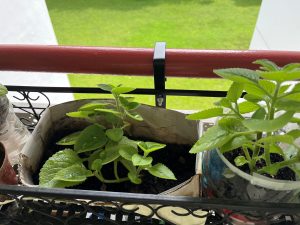Why Singapore’s English Teachers Should Embrace Singlish, Not Fight It
Is it time for Singaporean educators to embrace Singlish as a legitimate learning tool? What the Research […]
Read More
Contributed by Frances Ong Hock Lin, Alethea Goh Min Yi, Jeremy Ong Zhen Wei from Mayflower Secondary School, for SingTeach Virtual Staff Lounge.

From left: Jeremy Ong Zhen Wei, Frances Ong Hock Lin and Alethea Goh Min Yi
Balancing the needs of a growing population with environmental protection is a major 21st-century challenge. Sustainable development addresses this by adopting practices that ensure human and ecological well-being without compromising future generations. This article advocates for integrating Education for Sustainable Development (ESD) into geography classes to teach the skills needed to tackle global issues like climate change.
Chang (2011) highlights that geography education is well-suited for promoting ESD, as it covers current sustainability issues and helps students understand the complexities of environmental changes. Singapore’s current geography syllabus emphasizes the importance of sustainable development. Students learn about sustainable practices at various scales, highlighting geography’s essential role in preparing future-ready learners. Geography education is thus crucial for ESD as it develops ideas and beliefs about sustainable practices.
Building on ESD in geography education, we explore the transformative potential of IBL. In Singapore, geographical inquiry is a “signature pedagogy” (Seow, Chang, & Neil Irvine, 2019). IBL engages students by activating prior knowledge, fostering critical thinking and enhancing problem-solving skills. Unlike traditional teaching, IBL positions teachers as guides, encouraging students to ask questions, design solutions, conduct investigations and formulate explanations based on evidence, thereby creatively enhancing their learning experience.
IBL focuses on investigation and problem-solving. In contrast to traditional frontal teaching, IBL positions teachers as guides. It encourages students to: ask questions, design solutions, conduct investigations and formulate explanations based on evidence. This approach creatively enhances their learning experience.

Figure 1. Flowerpots created from recyclable materials.
Mayflower Secondary School’s Humanities Department envisions empowering students by putting students in the driver’s seat. They do this through IBL, fostering self-directed learning. They utilize ICT tools for this purpose. Three examples of IBL implementation will be highlighted.
In Secondary 1, students begin IBL by posing questions and conducting investigations. They explore sustainability by creating flowerpots from recyclable materials like plastic bottles and cardboard found at school (see Figure 1). These pots are used for planting Indian Borages, which they care for over a year and pass to the next cohort. Teachers guide them by asking questions such as how to ensure plants are watered during school holidays. This hands-on approach equips students with practical knowledge of sustainability in real-world scenarios.
In Secondary 3, instead of creating a PowerPoint and giving a lecture about how the impact of climate change can affect the human system, students are divided into groups to research the different impacts of climate change. Through a curated list of resources, students inquire about the impacts of climate change. They then have to process the knowledge and present it as an infographic for the school’s Open House exhibition.
For the lesson on climate action, students first played the game Getting to Zero to spark their curiosity. Using the framework of “Create, Connect, and Contribute” students are provided with an opportunity to discover for themselves the type of climate actions that they can take to fight climate change.
When using IBL, one constant fear we had was balancing curriculum coverage with student-driven inquiry. We addressed this by clearly defining learning objectives for each topic and designing inquiry-based activities aligned with these goals. Flipped classroom methods ensured students grasped fundamental concepts beforehand, allowing class time for deep exploration and critical thinking. This fosters comprehensive understanding of geographical concepts over rote memorization. Through meticulous planning and alignment with learning objectives, we aim to mitigate concerns about the breadth of content coverage while promoting meaningful student engagement and learning.
In addition, implementing IBL demands significant time and resources, which can tempt teachers with heavy workloads to revert to traditional frontal teaching. However, despite the initial investment, the long-term benefits of IBL outweigh this. Once IBL activities are designed and posted online, they can be reused in subsequent years, lightening the workload. Collaboration among teachers in developing IBL lessons further distributes the effort. Moreover, IBL enhances student engagement and motivation, ultimately improving learning outcomes. With experience, we have integrated IBL into our teaching practice without being overwhelmed, ensuring sustained benefits for both educators and students.
To address student reluctance with open-ended inquiry tasks, we scaffold their learning and build confidence gradually. We employ varied assessments like rubrics and peer evaluations throughout the process, shifting focus from just summative outcomes. Clear guidance on conducting mini-inquiries and analyzing data equips students for these tasks. Using ICT tools, such as Google Sites, Goggle Docs, Classroom, Canva, and Padlet, enhances engagement and accommodates diverse learning styles. These strategies ensure students are able to develop skills in navigating inquiry-based activities.
This article explores integrating IBL into geography education in Singapore through the lens of ESD. By embedding IBL within ESD goals, the aim is to foster critical thinking, problem-solving and a profound grasp of sustainability issues among students.
Three examples shared in this article illustrate IBL implementation across different educational levels despite challenges such as curriculum coverage, time management and resource allocation. Solutions include aligning learning objectives, using technology effectively and scaffolding inquiry processes.
Our experiences highlight that IBL enriches learning by equipping students with skills to tackle global challenges like climate change and biodiversity loss. This pedagogical approach not only enhances engagement and comprehension but also cultivates future-ready citizens capable of contributing positively to sustainability efforts. IBL emerges as a powerful method for nurturing informed, responsible individuals prepared to address complex issues and shape a sustainable future.
References
Chang, C.-H. (2011). Is Singapore’s school geography relevant to our changing world? Review of International Geographical Education Online (RIGEO), 1(2), 223-239. Retrieved from https://files.eric.ed.gov/fulltext/EJ1168710.pdf
Seow, T., Chang, J., & Neil Irvine, K. (2019). Field-Based Inquiry as a Signature Pedagogy for Geography in Singapore. Journal of Geography, 118(6), 227–237. https://doi.org/10.1080/00221341.2018.1561740